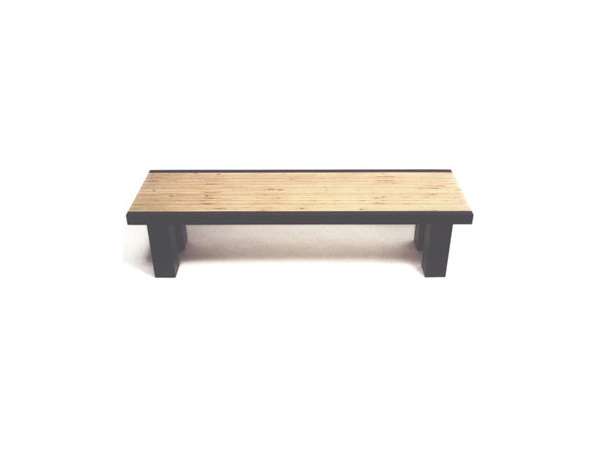
Meredith Sattler finds an intoxicating beauty and integrity in the machined straight edge of a sheet of plywood. Almost by accident, she discovered a rare talent for transforming humble sheets of plywood into striking pieces of furniture that bridge fine art and function.
It all started six years ago, while Meredith was on her way to India. The recent Vassar graduate had received a fellowship to study Tibetan art overseas.
“But I ended up deciding to stay in L.A..” Meredith explained. “When I got my own place, I didn’t have any furniture or enough money to have it made. So, I said, OK; I’m an artist, and I’ll figure out how to make stuff. So I went to a lumberyard and bought some plywood and had them cut it down for me.”
It was easy and inexpensive and she liked the results, but it was simply the furniture she needed. But then friends came over, saw the pieces, liked them, and asked her if she would build them one.
“At first I asked if they really wanted me to do this,” Meredith recalled. “It was fine for me, but I wasn’t sure it was good enough for other people, so I started to teach myself finer woodworking. I also discovered that I had this incredible relationship with plywood … particularly the edge. It’s never intended to be seen, but I think the edge is gorgeous without ever trying to be. It’s sort of a hidden surprise to me.”
In those early days, Meredith was working as a freelancer in the film industry, splitting her time between art direction and managing productions. Over time, just as she become frustrated with the erratic hours of film production, demand for her furniture was steadily increasing. Without really trying, she’d developed a clientele. She decided to give up show biz and see how far she could go with her furniture.
Though she was familiar with bigger power tools from her days in production, she’d never taken a class (and still hasn’t) and felt she needed to achieve a higher level of precision and ability to deal with those edges. Bill Ketelle, a woodworking instructor at a nearby college, helped her develop different systems and tooling.
“Plywood is more structurally stable than solid wood and lends itself to different kinds of joints. I do a lot of doweling and laminating so the joinery is invisible and the piece looks like it’s just there.”
These days, she does some work at her large loft apartment, but prefers her small shop in downtown L.A. On the fifth floor of a busy garment district building, her shop overlooks the city skyline and feels more like home (though raised mostly in Minnesota’s Twin Cities, Meredith was born in New York). She works mostly with hand tools, still preferring to have her plywood cut at a CNC cabinet shop.
“I like that smooth, flat edge they provide, so I’ll give them cut lists and they’ll do the initial cutting. Then I bring the parts back to my shop for assembly. I love to see the tension between the hard machine cuts and the fluidity of the small pieces of wood grain you see within the cuts. There’s incredible beauty hidden in those sheets that I love to reveal. I mix all my own stain colors, using Solar-Lux dyes, and the great thing is that all their colors are intermixable, so you don’t have any problem with chemistry, and that gets me back to my background in art.”
Design is her favorite part of the process: she finds inspiration for her work from life, science, and mathematics (she loves Einstein and theoretical physics). When doing a commissioned piece, she prefers to see the client’s home and sketches ideas. She likes the way French surrealist Marcel Duchamp looked at the human mind and perceptions, and the revolutionary furniture designs of husband and wife team Charles and Ray Eames. More design ideas come to her than she’ll ever have time to build.
“Furniture is the most intimate art form, because a chair asks you to sit and then holds you there. It’s so physical and tactile; it’s almost like lovers. I love the puzzle of putting together the functional need, the materials, and the desire of the client to design the structure. Only when that’s all worked out will I start adding finishing aesthetic touches. It’s the opposite of the way most people approach art, but putting aesthetics in furniture design ends up with crazy projects that aren’t safe and never do what they’re supposed to do.”
Along the way, Meredith approached a local store called “Homework” and found their aesthetic jibed with hers. She worked with them to develop a product line of modular cubes, which could be bookcases, storage or display units. Production work like that is a bit of a dilemma for her. She’s currently working on a couple of commissions for larger versions of storage cubes and has started to think about how to put the cubes into production. But, as she puts it, it’d be like letting go of her baby.
“My work will always be a mix of production and new pieces,” Meredith declared, “though ideally I’d like to move into other mediums and forms, perhaps doing larger architectural scale pieces.”
“I don’t consider myself a fine woodworker the way most people do,” she added. “I have always had ideas about what I wanted to do, and the material (plywood) gives me information about what it can communicate. Everyone has that something that they see really clearly, and just have to do it. Whatever you need is inside you.”





